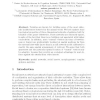Free Online Productivity Tools
i2Speak
i2Symbol
i2OCR
iTex2Img
iWeb2Print
iWeb2Shot
i2Type
iPdf2Split
iPdf2Merge
i2Bopomofo
i2Arabic
i2Style
i2Image
i2PDF
iLatex2Rtf
Sci2ools
BIOWIRE
2007
Springer
2007
Springer
The Topological Fortress of Termites
Abstract. Termites are known for building some of the most elaborate architectures observed in the animal world. We here analyse some topological properties of three dimensional networks of galleries built by termites of the genus Cubitermes. These networks are extremely sparse, in spite of the fact that there is no building cost associated with higher connectivity. In addition, more “central” vertices (in term of betweenness or degree) are preferentially localised at spatial positions far from the external nest walls (more than in a null network model calibrated to exactly the same spatial arrangement of vertices). We argue that both sparseness and the particular spatial location of “central” vertices may be adaptive, because they provide an ecological advantage for nest defence against the attacks from other insects.
| Added | 07 Jun 2010 |
| Updated | 07 Jun 2010 |
| Type | Conference |
| Year | 2007 |
| Where | BIOWIRE |
| Authors | Andrea Perna, Christian Jost, Sergi Valverde, Jacques Gautrais, Guy Theraulaz, Pascale Kuntz |
Comments (0)

